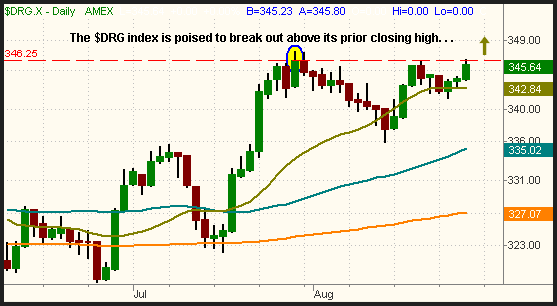A day after breaking below support of their four-day trading ranges, the major indices creeped back up, but chop and indecision again prevented stocks from making much headway. The Nasdaq Composite gapped 0.4% higher on the open, sold off to a 0.2% loss at mid-day, then recovered to finish 0.1% higher. Both the S&P 500 and Dow Jones Industrial Average displayed similar intraday action and gained 0.2% and 0.1% respectively. The small and mid-cap arenas again showed relative weakness. The Russell 2000 was unchanged and the S&P Midcap 400 Index lost 0.2%. Over the past several years, the Russell and S&P Midcap indices have become leading indicators for the direction of the broad market, so their lagging action of the past week is not a good sign for the stock market overall. It is, however, beneficial for our short position in the iShares Russell 2000 (IWM) and long position in the UltraShort S&P Midcap 400 (MZZ).
Turnover was mixed, but remained well below average levels and in line with typical late-August lethargy. In the NYSE, total volume increased by 4% over the previous day, but volume was 4% lower in the Nasdaq. Market internals also showed a mixed bag. Advancing volume was on par with declining volume in the NYSE, but was positive by a 2 to 1 ratio in the Nasdaq. It remains difficult to draw any intelligent conclusions regarding the market's true underlying health while many professional traders and institutional players are enjoying their summer vacations. Market action is likely to remain a bit ambiguous until after the Labor Day holiday has passed.
Perhaps the primary reason that stocks took a roller coaster ride yesterday was the divergence between the Semiconductor Index ($SOX) and most other industries. While sectors such as Retail and Broker-Dealers sported significant losses and weighed on the broad market, many tech stocks moved higher. When such incongruousness is present, it usually results in choppy intraday price action for the stock market, especially when lower volume fails to confirm either strength or weakness.
The beaten-down $SOX index rallied a whopping 10% last week, and corrected 3% lower in the first three days of this week. Since the retracement in the $SOX has been rather orderly, one must expect that buyers would soon return to the sector and attempt to keep the upside momentum going. That is precisely what happened yesterday afternoon, as traders reversed a morning loss and attempted to push the $SOX above resistance of its hourly downtrend line. At yesterday's lowest level, the $SOX had retraced less than half of the gain from its August 11 low to its August 17 high. Thus far, the correction has been shallow enough to keep the short-term uptrend intact. Based on last week's strength and the well-mannered retracement, we expect the $SOX will test resistance and attempt to break out again within the next day or two. We have illustrated resistance of its short-term downtrend line on the hourly chart of the $SOX below. Moving averages have been removed so you can more easily see the trendline:

If the $SOX breaks out above the resistance illustrated above, it's probably worth a shot to buy one of the Semiconductor ETFs such as the Semiconductor HOLDR (SMH) or the iShares Semiconductor (IGW). However, we advise keeping a tight trailing stop and not expecting a huge gain. You might even consider selling into strength if the $SOX nears its August 17 high, then planning to re-enter your position if the index consolidates and breaks out to a new high. In this environment, that is a more prudent way to play the strong sectors as opposed to holding on in anticipation of a new high, only to watch your profits fade away when the ETF falls back down.
In addition to the chip stocks, keep an eye on the Pharmaceutical Index ($DRG). The sector is now poised to break out and resume last month's uptrend after having corrected and consolidated for several weeks. Take a look:

If the $DRG index breaks out, you might consider buying one of the Pharmaceutical ETFs. However, breakouts have had a high rate of failure lately, so we again advise a short-term time horizon and a tight trailing stop. IHE, PJP, and PPH are a few of the ETF ticker symbols that are tied to the Pharmaceutical sector and have similar charts to the $DRG index. A complete list of all associated ETFs can be found on the Morpheus ETF Roundup guide.
Deron Wagner is the Founder and Head Trader of both Morpheus Capital LP, a U.S. hedge fund, and Morpheus Trading Group, a trader education firm launched in 2001 that provides daily technical analysis of the leading ETFs and stocks. For a free trial to the full version of The Wagner Daily or to learn about Wagner's other services, visit MorpheusTrading.com or send an e-mail to deron@morpheustrading.com.